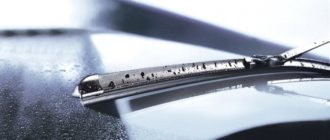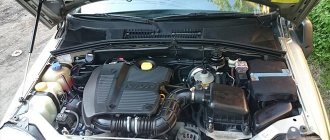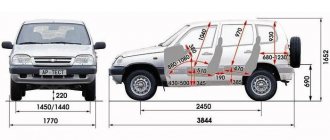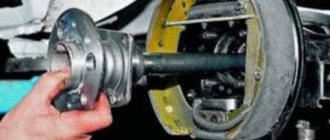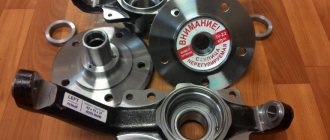Rate this post
Lada 4×4 is a full-fledged SUV from the domestic automobile industry, which began to be produced back in the 70s of the last century. This car has become a faithful companion for lovers of off-road travel; it attracts with its affordable price, unpretentiousness and compact size. The follower of the Lada4×4 was the Chevrolet Niva; it is still assembled at the plant in Tolyatti. It features a more modern interior and exterior, but retains excellent cross-country ability and all-wheel drive transmission. Let's look at how the Lada 4×4 and Chevrolet Niva all-wheel drive is designed and how it behaves in different road conditions.
Design and principle of operation of the Niva 2121 transfer case
The chassis of the car is made on the principle of permanent all-wheel drive - torque from the power unit is transmitted to all 4 wheels. This scheme improves the performance of the car when driving in off-road conditions, while simultaneously reducing the load on transmission parts.
The Chevrolet Niva drive consists of the following components:
- Gearbox.
- Transfer case.
- A pair of drive and cardan shafts.
- Front and rear axle gearboxes.
The transfer case is designed to distribute torque between the drive axles of the vehicle. The car is equipped with a two-speed transfer case, which provides:
- stable running of the machine when driving at low speed and at high engine speeds;
- power distribution between drive axles, depending on road grip.
The differential is one of the most important elements of the transmission. Its main purpose is to distribute traction force, and, if necessary, ensure rotation of two consumers at different angular speeds. The Chevrolet Niva drive transmission has three differentials:
- One for each axle (interwheel) - enable the wheels of the same axle to rotate at different speeds.
- The third (interaxle action) - transmits power from the power unit to both axles of the vehicle. It also allows the shafts to operate at different angular speeds, depending on operating conditions, which significantly improves controllability.
A pair of cardan shafts (CV joint or cross design) provide connection between the transfer case and the drive axle gearboxes. Both car shafts have the same design - they are interchangeable.
The front and rear axles transmit force from the transfer case to the drive wheels through external and internal angular velocity joints.
In normal mode, the Chevrolet Niva operates in high gear with the differential unlocked. Torque is transmitted from the power unit, through the gearbox and intermediate shaft, to a two-stage transfer case gearbox. A center differential is installed in the transfer case housing. It links the front and rear axles, allowing them to rotate at different speeds, depending on road conditions and direction of travel.
The transfer case mechanism includes more than 60 independent parts, which is confirmed by the presented drawing. Therefore, it is quite prudent to name the main elements and their purpose.
- Housing Differential housing Shafts Couplings Seals Pinions Gears Flanges Levers
A pair of gears are tightly seated on the drive shaft, one of them (large) is intended for high gear, the second (small) is responsible for low gear. They have serrations with straight and oblique profiles. The first ones are in contact with the coupling, the second ones - with the intermediate shaft. The inclusion of one or another row causes the coupling to move along the hub in the horizontal direction, after which it is connected to the gear on the transfer case drive shaft.
The intermediate position turns off the gearbox (the gearbox is open), and the vehicle cannot be moved in this mode. The front helical gear on the intermediate shaft is used to control the differential. The locking is engaged, or the rigid coupling of the drive shafts of both axles, is carried out through a clutch. The design is typical for modifications 21213 and 21214, and the latter is additionally equipped with a speed sensor drive.
In the operating state (with the transfer case reduction gear connected), the gear ratio in the first stage changes from 4.4 to 7.83, the second - from 2.52 to 4.58, the third - from 1.63 to 2.9, in the fourth - from 1.2 to 2.14, fifth - from 0.98 to 1.75, which is expressed in an increase in traction on the wheels.
Also interesting: VAZ 21213 transfer case device, diagram, alignment, removal of transfer case
Transfer case malfunctions
The transfer case is a complex unit, so it is important to correctly diagnose the malfunction and be able to quickly fix it. The most common sign of its incorrect operation is increased vibration.
If it is observed when driving in various modes, then the cause may be wear of the elastic coupling.
A visual inspection will help verify this. Vibration under direct load (acceleration) indicates a loose attachment of the transfer case to the body, a faulty CV joint on the intermediate shaft, or a jammed joint on one of the cardan shafts. If vibration is observed at a constant speed, then there is a problem with the balancing of the cardan shafts themselves or the differential.
Malfunctions often occur due to difficulty switching modes
Here attention should be paid to the hinges of the control mechanism, as they usually become clogged with dirt. The fork or stem may be deformed
Over time, nicks appear on the splines of hubs and gears. They can be easily removed by grinding, but to identify the defect you have to remove and disassemble the entire assembly.
Preventive maintenance includes timely replacement of transmission lubricant. It is performed every 45,000 km
It is important to follow the rules for switching modes during operation, and also carefully monitor the timely unlocking of the differential
Design and principle of operation of the Niva 2121 transfer case
The VAZ 2121, in other words, “Niva”, entered mass production in the 70s of the last century. This car belongs to the class of off-road passenger cars. In the history of the domestic automobile industry, Niva became the first car whose design used all-wheel drive. Let's take a closer look at the transmission device.
The transmission in the Niva family (2121, 2131) is designed in such a way that all-wheel drive is supplied to 4 wheels. Also characteristic is the presence of a center differential. The transmission includes a gearbox, a transfer mechanism, a pair of cardan shafts, and both axles. A characteristic feature of the 2131 model is its elongated body.
Then it goes through the cardan shafts to the gearboxes. The front gearbox transmits torque to the wheels through the differential and constant velocity joints. Likewise for the rear, also protruding, driving wheels. It is precisely because the torque is distributed to 4 wheels simultaneously that the drive is called full drive. The designation is as follows – 4WD. Another domestic car, designed on a similar principle to the Niva, is the UAZ.
External CV joint Niva, history
The main difference that the owner of a Niva or Chevrolet Niva should know. CV joints come in 22 or 24 splines, for cars with and without ABS. Grenades with 22 slots were installed mainly on carburetor fields. With the transition to injection and restyling in 2008, they were no longer produced. Then there are only 24 slots. The 22 slot grenades had two serious advantages. They were smaller in diameter and, as a result, there was more “meat” on the hub. Such a breakdown as a hat breaking off on the hub almost never happened. Second point. Old fields were exported to Europe in fairly large quantities, and there they spit on AvtoTAZ and made their own spare parts. I brought grenades from Loebro, SKF, GKN-Spidan, GLO - all of these are high-class manufacturers in the field of drives and CV joints. Unfortunately, none of these companies makes CV joints for 24-spline fields. There are a lot of bright boxes on the market, but most of them are brands made only for Russia. In the future we will only talk about CV joints with 24 splines.
How to turn on all-wheel drive
Since the drive on the Niva is constantly all-wheel drive, the question of how to turn on the all-wheel drive on the Niva Chevrolet means how to turn on the center differential lock.
You need to use blocking in the following cases:
- when driving in difficult terrain where there is a danger of wheel slipping;
- when there is a lack of engine thrust;
- when driving on a road covered with snow or ice.
The main component of the axle locking mechanism is the transfer case. The transfer case is controlled by one six-position lever. The longitudinal stroke provides higher and lower gear rows. Transverse - responsible for locking the center differential. When the lever is in lock mode, a yellow icon lights up on the instrument panel.
Operating principle of the drive.
By default, the SUV uses high gear with the center differential disabled. The engine transmits force to the gearbox, which is fed through the shaft to the transfer case gearbox. The transfer case contains a center differential, which connects the front and rear axles.
How does all-wheel drive work on a Chevrolet Niva if the differential is locked.
If you turn on all-wheel drive on the Niva, the cardan shafts will be blocked using a special clutch. In this case, there will be an even distribution of torque between the axles. The vehicle's cross-country ability will increase significantly, but at the same time, handling will become slightly worse.
Diagram and description of the Niva 2121 transmission
The legendary Niva is an all-wheel drive vehicle. This ensures unprecedented road holding and reliability comparable to expensive high-performance cars. With the exception of updated versions under the Chevrolet brand, the traditional Niva has always had a rather modest design, but this did not prevent it from being the undisputed leader among car owners who prefer high-end car platforms.
What distinguishes the Niva's chassis from other all-wheel drive vehicles is the transmission of torque to two axles at once without disabling the axles, which significantly affects cross-country ability while simultaneously reducing the influence of critical loads on the transmission. This same quality makes this legendary Russian SUV very uneconomical in terms of fuel consumption.
Transmission Chevrolet Niva
Chevrolet Niva transmission: 1, 3 — front wheel drives;
2 — front axle gearbox; 4 — clutch; 5 — gearbox; 6 — front driveshaft; 7 — gear shift lever; 8 — intermediate shaft; 9 — transfer case control lever; 10 — transfer case; 11 — rear propeller shaft; 12 - rear axle. Chevrolet Niva transmission: 1, 3 — front wheel drives; 2 — front axle gearbox; 4 — clutch; 5 — gearbox; 6 — front driveshaft; 7 — gear shift lever; 8 — intermediate shaft; 9 — transfer case control lever; 10 — transfer case; 11 — rear propeller shaft; 12 - rear axle. The Chevrolet Niva has permanent all-wheel drive - torque from the engine is always transmitted to both axles (the axles are not disabled). This scheme increases the vehicle’s cross-country ability, while simultaneously reducing the load on the transmission units, but slightly increases fuel consumption.
Nivov transmission units
The developed Niva transmission turned out to be so successful and efficient that it later became a prototype for the Vitara. This made the new model more adaptable to difficult roads. Niva transmission units can easily meet the requirements of any engine up to 2 liters, so if you want to upgrade, think about the fact that each car has its own capabilities. Many advantages are due precisely to the circuit and design of the transmission.
Niva transmission and its components:
- front-wheel drive;
- front axle;
- wheel grip;
- manual transmission;
- driveshaft (front);
- shaft (intermediate);
- transfer case;
- shift lever;
- center differential and locking lever;
- wheel differentials;
- driveshaft (rear);
- rear axle;
- rear drive.
The design implies the following states:
- unlocked differential;
- locked differential;
- low gear when engaged;
- neutral position;
- top gear engaged.
What are the types of blocking?
Operation of the front axle UAZ 469
Usually there are two types - inter-wheel and inter-axle. The first ones block the operation of the differential installed between the wheels on one axis. The purpose of the interaxle blocking is to ensure the distribution of forces between the axles.
The Niva has three differentials, a center differential and two cross-axle differentials. But they are fundamentally different. If the inter-axle differentials are free, there are no additional devices on them, then the inter-axle differential has a forced lock. It greatly facilitates the movement of the vehicle in off-road conditions, partially giving it the capabilities of an all-terrain vehicle.
Features of the Nivov design
The features of the Nivov transmission include the presence of a center differential that connects the rear and front axles. As a result, the wheels can rotate not only at different angles, but also at different angular speeds, which significantly affects controllability in impassable roads.
The key difference between the Niva’s center differential is the ability to lock when driveshafts rotate with the same characteristics. The center differential is manually locked only in difficult terrain conditions, when you need to overcome a large hole, rut or snow drift without slipping.
In practice, mechanical locking, although somewhat inconvenient, turns out to be better than the modern electromagnetic clutch used for these purposes. For example, the Renault Duster is not so easy to cope with the task in harsh off-road conditions, since the digital control unit can provide limited torque transmission. However, this effect will not be observed in a Niva with a mechanical lock.
Also interesting: Gearbox Lada Niva Chevrolet manual transmission
Leaving the center differential locked will not only cause increased wear, but will also significantly reduce the vehicle's handling. The activated differential lock mode will be indicated by a lit indicator on the Niva dashboard. Please note that locking will not prevent one wheel from losing traction.
To overcome difficult areas, the transmission allows the use of a low gear with a high gear ratio (2.135); in the highest gear, the parameter is 1.2 and is intended for driving in normal conditions. The transfer case indicates different high and low gear modes. The lower one is turned on before entering a snowy area, unsteady soils, hills, and when a towed load is connected.
Some drivers master the skill of shifting gears at speeds of 30-35 km/h. Otherwise, you will have to stop the car and perform the operation in the parking lot.
Please note that Niva requires a competent approach to the selection of tires, the quality of which can affect the degree of wear of the transmission in just one season. The tires must be the same in terms of wear and, of course, in size. Different characteristics will lead to increased load on the transmission and slipping in low gear, and during normal driving will increase wear on the differentials.
Transmission
The Chevrolet Niva gearbox has no structural differences compared to the Lada 4x4 box, and they are identical in design. The difference can only be noticed in the mounting and length of the gear shift drive. Another important feature is the presence of 5th gear.
The main parameter of the gearbox is the gear ratio. By trivial definition, this is the ratio of the number of teeth of the driven shaft to the number of teeth of the drive shaft. Naturally, we talk about the gear ratio when there is actually a transfer of torque from one shaft to another. If the specified parameter is greater than 1, then such a mechanism works to increase torque. The gear ratio for IV gear is 1, and for V – 0.82. That is, in V gear there will be an increase in the number of revolutions of the secondary shaft with a parallel decrease in torque. It is more convenient to imagine the value of the gear ratio using the sprockets of a high-speed bicycle.
Modified versions
The Niva's standard transmission, for all its advantages, often causes uncomfortable noise in the cabin. This is generally related to the design, but using engineering developments, you can modernize it and make the car much quieter.
This approach has already been applied in VAZ-21213 cars; as a result, even at a speed of 100 km/h you don’t feel any unpleasant noise, you can talk calmly and hear your interlocutor without effort. For these purposes, a number of modernization methods have been used: from unloading the floor near the transfer case and manual transmission mounts, reducing the load on shaft bearings to smoothing out peak torques under conditions of increasing loads on the transmission.
The noise in the modernized Niva transmission is comparable to that of a Zhiguli. It becomes more comfortable to be in the car when driving off-road. Upgrade costs are negligible; modification requires only the master's understanding of the design itself and a little time.
Differential locking
Sometimes you can come across a misconception about why a small handle is needed next to the shift lever on a Niva. Some car owners believe that it is needed to connect front-wheel drive. However, the front-wheel drive of this car is permanently connected. As is the rear one. Cars of the Niva family have permanent all-wheel drive. The handle actually serves to switch the operating modes of the differential of the transfer mechanism.
In the “forward” position, the differential operates as usual, but if you move it back, the differential is locked, and the forces from the motor are applied to the differentials of the axles, which makes the drive more rigid. It is worth noting that there are also special types of locks for front and rear axles.
In theory, when used in conditions where the car is stuck, it will be able to overcome the obstacle if there is sufficient traction on at least one wheel. In this case, it is better to lock the differential before overcoming an obstacle, but never after entering an area that is difficult to overcome. This application of locking will avoid wear and damage to the transmission.
Gearbox and clutch Niva Chevrolet
The Niva has virtually the same VAZ gearbox, but with minor changes designed to increase the durability of the unit. Firstly, this is the replacement of the VAZ rear bearings of the primary shafts and intermediate bearings on the secondary shafts with similar, but sealed types. This eliminates bearing malfunctions associated with contamination and premature wear. Secondly, the gear shift control drive has been changed. It is easy to notice that in a Chevrolet the gearbox control lever is closer to the driver, which makes control more convenient. This was achieved through the use of an extension with a 250 mm horizontal rod. Gear ratios remain the same, as does the gear shift pattern.
The clutch device in the Chevrolet Niva transmission has undergone some changes and received a number of improvements and more progressive parts from front-wheel drive VAZ cars.
A series of downshifts
You can often encounter the following type of misconception: switching the rear handle can increase the power characteristics of the motor. But this is not true. It serves to change the gear ratio between the engine and the wheels. By increasing it, the traction forces on the wheels will increase. There is also a reduction gear in the dispensing mechanism.
DON'T SPEND MONEY ON REPAINTING! Now you can remove any scratch from the body of your car in just 5 seconds.
Also interesting: Homemade all-terrain vehicle on low-pressure tires (45 photos)
Its operation can be controlled using the rear handle. When we shift the lever back, we will have a gear ratio of 2.135 - this is a low gear. It is recommended to downshift such a gear only when the car is stationary and the clutch is depressed. Despite the fact that the manual does not contain such a restriction, novice and inexperienced Niva drivers are not recommended to switch while driving, since the Niva transfer mechanism is not equipped with a synchronizer.
Tips for owners
To make driving your car comfortable, read some important points:
- The usual, standard arrangement of the front and rear handles is forward and backward, respectively. Movement in this mode can and should be carried out in areas characterized by even and smooth surfaces.
- Locking the differential by switching the front handle to the rear position is best on roads characterized by increased slipperiness. This measure will give Niva stability. It is worth understanding that after overcoming the problem area, the handle will need to be returned to its original position.
- As noted earlier, downshift should be activated before a potential obstacle, but not while the car is already stuck.
- It is worth understanding that activating the lock when the vehicle is stationary is sometimes impossible, even if the clutch is depressed. This may be caused by the clutch teeth hitting the gear teeth. In this case, you can try to activate the lock by starting to drive slowly and make a slight turn. If problems arise with disabling the lock, it is recommended to perform the same procedure with the clutch depressed and the steering wheel slightly rocked.
How to use a transfer case with a range multiplier on a Niva 2121
The relatively complex scheme for distributing torque from the internal combustion engine to the wheels is explained by the universal purpose of the Niva 2121 - if used correctly, it can be used comfortably in the city and along muddy country roads. Such properties are ensured by the presence of a transfer case with a center differential lock, complementing a 4- or 5-speed manual transmission, depending on the year of manufacture.
The normal position for the RK handles, ensuring adequate behavior on the road of good quality:
- Front - away from you Back - towards you
The special operating mode of the transmission is switched on not long before the car begins to overcome an obstacle (rut, mud, ford or rise). The transition to the lowest row must be done while stopping. Returning to top gear is allowed on the go, although it causes problems for beginners due to the lack of the usual synchronizer.
It is somewhat more difficult to properly handle the forced manual locking of the center differential. On the contrary, it turns on when the car moves slightly (up to 20 km/h) due to misalignment of the grooves on the locking clutch, satellites and ring gear. To simplify turning the lever into the desired position, taking into account the Niva 2121 transfer case, pick up a small speed, then, shaking the steering wheel, pull the handle towards you.
Problems can also arise when disengaging the lockout, as the clutch teeth literally catch on the ring gear. Engage reverse and, rocking the steering wheel, push the lever away from you. This action is performed immediately after overcoming a difficult section in order to avoid overloading the gearbox. It is most effective to disable the differential together with the transition to lower stages.
Read news about the new Niva
- All-terrain vehicle fracture 4x4: photo of step-by-step assembly video of a trip on an all-terrain vehicle
- Homemade all-terrain vehicle on low-pressure tires (45 photos)
- Dismantling and assembling the gearbox Niva 2121, Niva 2131
- Nissan engine on a Niva – Replacing a Niva engine with a Japanese one
- FROST car air conditioners // Online store // Prices // Air conditioners for cars Lada VAZ, VolksWagen Polo, Daewoo Matiz
- Transfer case Niva VAZ - do-it-yourself repair and replacement
- Transfer case Niva 2121: principle of operation, repair
- Gearbox VAZ-21213 Lada Niva, VAZ-21214 Lada 4x4, diagram
Description of possible problems with the transfer case
During the operation of off-road vehicles, parts and components of the transfer case gradually become unusable due to wear. Most often, the following interruptions in the operation of the mechanism occur:
- The front axle does not engage.
- The transfer case is overheating.
- Leaks and increased oil consumption of the transfer case.
- Unauthorized disabling of the front axle.
Changing the oil in the transfer case Niva 2121
To ensure the performance of the vehicle, it is necessary to carry out timely maintenance. Changing the oil is included in the mandatory list of machine maintenance work. To change consumables in the Niva 2121 transfer case, you will need 0.8 - 1.5 liters of gear oil.
The frequency of replacing lubricating fluid is equal to 45,000 km of distance traveled. The first procedure is carried out after 60,000 km, and then in accordance with the established schedule.
The procedure for changing the oil in the transfer case of a Niva SUV:
- warm up car systems and mechanisms, to do this you need to start the engine and drive a short distance;
- install the machine on an overpass or over a special inspection hole;
- clean the filler and drain plugs of the transfer case from dirt and dust;
- place a container under the drain to collect waste material;
- unscrew the plugs and drain the liquid;
- remove metal fragments, shavings, splinters and other wear elements;
- screw in the plug;
- pour into the washing liquid (about one liter);
- start the engine;
- move the lever through the transfer case gears with slight delays;
- turn off the engine;
- drain the flushing composition;
- fill the transfer case with new oil;
- check the oil level;
- if necessary, add the required amount.
For the transfer case of the Niva 2121 SUV, transmission oils of the famous brands Mobil, TNK, Castrol of the GL-4 class are most often used.
VAZ 2121 Niva has established itself as a reliable and versatile Soviet SUV. In 1977, the first domestic all-terrain vehicle rolled off the assembly line, which, unlike ordinary passenger cars, the VAZ 2121, had all-wheel drive and increased cross-country ability. The Niva transfer case design was developed by experienced AvtoVAZ designers in order to increase the functionality and versatility of the vehicle both when driving off-road and in city conditions.


